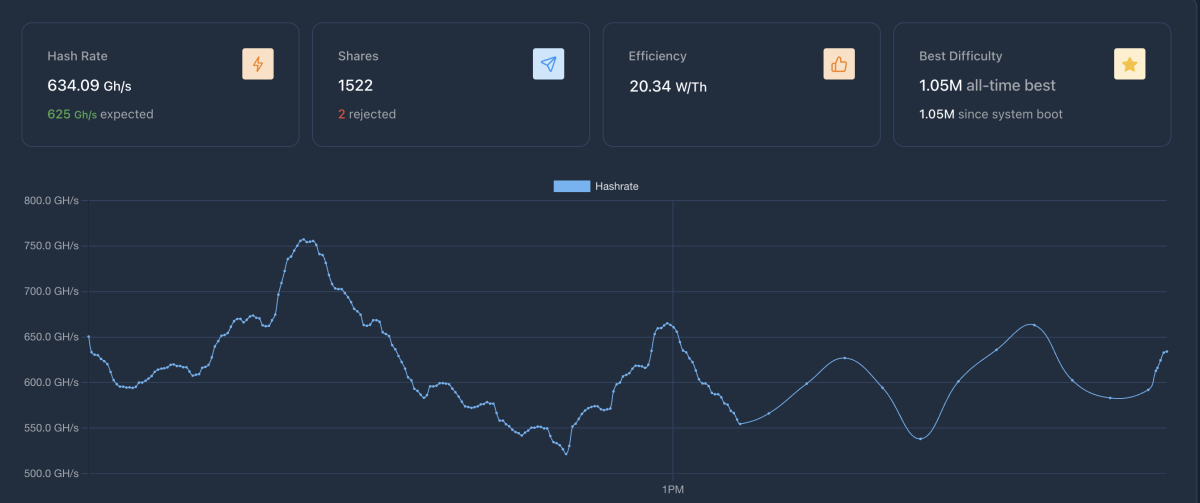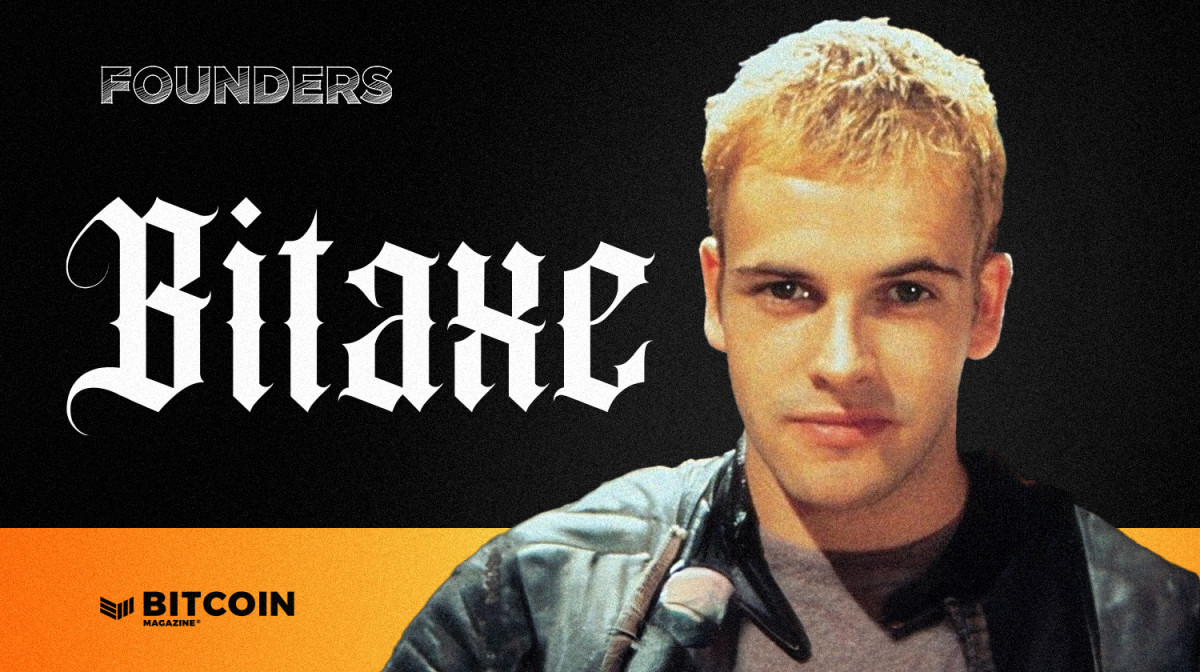Bitaxe
I Just Entered the Bitcoin Mining Lottery: NIKOLAUS
Published
1 month agoon
By
admin
When I first came onto the Bitcoin scene in 2017, I had changed my Twitter (now X) handle to “@nikcantmine.” (It was a joke I thought was funny at the time since I didn’t have the resources to mine BTC in high school.) But today, I officially became “nik CAN mine”.
The other week I got gifted a Bitaxe, a fully open source (and very small) bitcoin miner, while attending the Human Rights Foundation’s Bitcoin Summit in Nashville. It’s a pretty neat device that allows you to connect to a mining pool or solo mine on your own.
nik CAN mine pic.twitter.com/Mv1OuTyvBM
— Nikolaus (@nikcantmine) October 8, 2024
Setting up the device was fairly easy. Tinkering with it was fun and having the ability to hold a miner in the palm of my hand felt pretty cypherpunk. It feels like a cool way to introduce someone to mining on a very small scale.
Of course, by connecting this miner to a pool, I wouldn’t stand to gain any real profit, as this miner is negligible compared to what power is actually needed today to profitably mine BTC today. But solo mining with this machine is where things get a bit interesting.
Earlier this summer, a Bitaxe solo miner actually beat the odds and mined a solo block, earning the block reward of 3.25 BTC currently worth over $205,000.
Congratulations to miner with the first bitaxe block, only a tiny 3TH for finding the 290th solo block on solo ckpool! This much hashrate only would find a block once every 3500 YEARS on average, or 1 in 1.2 MILLION chance per day! https://t.co/5Wtu9jydsF pic.twitter.com/D5sSzug42P
— Dr -ck (@ckpooldev) July 24, 2024
Data shows this miner had mined consistently with 500Gh/s worth of hashrate for weeks, and then had increased its hashrate up to 3TH right before the block was found. Which somewhat encourages me knowing that my Bitaxe is currently mining at over 634Gh/s.
But I’m not getting my hopes up, considering I don’t have more hashrate to add and the odds of finding a block with this little hash rate is around 1 in 1.2 million per day, according to the Solo Ckpool admin, Dr -ck.

Still, I got this machine for free, so I thought why not plug it in and see what happens? I’ll deal with the power bill later when I see how much it is, and re-evaluate if this is worth it to keep running. Having used it, I probably wouldn’t purchase one based on the economics of it alone, since I wouldn’t be able to make my money back unless I hit the lottery. But I would maybe purchase one just to have as a fun toy.
The odds of me finding a block is 0.001% per day, but it honestly just feels fun to have running in hopes of finding a solo block. I can keep my Bitaxe running 24/7 if I want to, since it only requires a 5-volt power cord plugged into a normal electrical socket to operate. I’ve got it set up right here on my desk next to my monitor.

Together with a new Coldcard Q I just got, I couldn’t stop thinking about how cool it would be to win a solo block mining with this and have that BTC reward sent to a brand new bitcoin wallet.
This would mean there is no public record of me receiving either the Bitaxe or Coldcard (apart from this article), and I’d have some sweet KYC-free Bitcoin.
This article is a Take. Opinions expressed are entirely the author’s and do not necessarily reflect those of BTC Inc or Bitcoin Magazine.
Source link
You may like


UK government is ready for crypto regulations next year


“Crypto Dad” Chris Giancarlo Emerges Top For White House Crypto Czar Role


Bitcoin Nears $100,000 As Trump Council Expected To Implement BTC Reserve


Know Your Missiles: Russia’s Experimental Hypersonic Missile Is A New Kind of Killing Machine


Polkadot investor predicts a 30,000% rally for this $0.04 token by 2025


Donald Trump Proposed Crypto Advisory Council To Set Up Strategic Bitcoin Reserve
Bitaxe
Bitaxe And The Open-Source Bitcoin Mining Movement
Published
4 weeks agoon
October 23, 2024By
admin

Company Name: Bitaxe
Founders: Skot
Date Founded: Early 2023
Location of Headquarters: North Carolina + remote team
Amount of Bitcoin Held in Treasury: N/A
Number of Employees: ~12 regular contributors
Website: https://bitaxe.org/
Public or Private? Open-source project (not a company)
Bitaxe’s founder, who goes by the nym Skot, has taken his hobby of tinkering with electronics and not only transformed it into a full-time gig but has catalyzed thousands to follow his lead.
Harnessing his training as electrical engineer and his Bitcoin enthusiasm, Skot began deconstructing Bitmain’s Bitcoin mining machines approximately two years ago. After gaining a better understanding of how they work, he reverse engineered one, creating the blueprint for Bitaxe — the first ever open-source ASIC-based Bitcoin mining machine — in early 2023.
“It was just a technical challenge initially,” Skot told Bitcoin Magazine.
That technical challenge has transformed into something bigger than he ever could have imagined, though. Skot created a low-power and affordable Bitcoin miner that anyone can plug in at home without running up a huge energy bill, while his work also paved the way for others interested in open-source Bitcoin mining to begin contributing to Bitaxe and other open-source mining initiatives like it (and related to it).
“The project has morphed into something that’s bringing mining back to the open source fundamentals of Bitcoin itself,” Skot said.
“I’ve really become convinced that to be truly decentralized, which I think most people understand Bitcoin needs to be, all aspects of the development of Bitcoin needs to be open source,” he added.
“It needs to be open so that anyone who’s even remotely interested can get in.”
Skot’s Journey To Bitaxe
Years back, while taking liberal arts courses at a community college, Skot stumbled on an issue of Make Magazine, a publication that features tutorials for DIY electronics projects. A switch flipped inside of him as he perused the magazine.
He completed a degree as an electrical engineer and then co-founded a design consultancy for Internet of Things (IOT)-related products, which he ran for 10 years. Skot enjoyed the work, but admitted that the downside was that he was constantly working on other people’s ideas.
In 2011, a friend introduced him to Bitcoin at a party — showing him how to use bitcoin to buy drugs on the now defunct Silk Road. While he was intrigued, it wasn’t enough to get him to buy bitcoin (or drugs) at the time.
Two years later, Skot learned about Bitcoin mining, and, soon after, built his first Bitcoin miner.
“I actually built a FPGA Bitcoin miner,” recalled Skot. “FPGAs were the precursor to ASICs.”
FPGA miners were designed with open-source code, making it easy for Skot to figure out how to construct one.
While he lost all of the bitcoin that he mined in a pool hack, he didn’t become discouraged. In fact, he became more fascinated with this cross section of electronics and the permissionless nature of Bitcoin.
“When I was learning about it, I was like, ‘Well, okay, so these are the rules of how Bitcoin mining works, but who made these rules? Who enforces these rules?’” recounted Skot.
“Learning that no one is at the center of this and no one enforces these rules — or we all do — was mind-blowing. It’s a beautiful thing technically, and that intrigued me,” he added.
A few years later, he dove in deeper and developed the Bitaxe.
What is Bitaxe?
A Bitaxe is technically just open-source code that anyone can use to build a physical mining machine.
Skot has only built about a dozen Bitaxes himself, while thousands have been built and sold. Anyone can build and sell Bitaxe’s under its open-source license.
The circuit board for physical Bitaxes isn’t much bigger than a credit card, while the device’s fan protrudes out about 3 cm from the board. (There are different versions of Bitaxes that vary slightly in size.)
The machine runs on a 5 volt power source and connects to the internet over WiFi. Users interface with Bitaxes via their personal computer or phone. The devices use between 12 and 18 watts of electricity, which is comparable to an iPad charger.
Running a Bitaxe full-time should only increase users’ energy bill by a few dollars per month (this varies based on jurisdiction), and it costs less than what running a Bitcoin node costs to run.
The odds of finding a block with a Bitaxe are infinitesimally low (though, a Bitaxe did find a block this past July), but users can direct the hash power they produce with their Bitaxe to almost any mining pool for smaller payouts.
Ideally, Bitaxes are used to decentralize the hashrate, though this will, in the end, only lead to really meaningful decentralization if mining pool centralization decreases along with it.
“My hope is that by decentralizing the number of brains that are operating these things that enough people will make different decisions,” explained Skot. “If we can exponentially increase the number of different brains and all the crazy ways that they think, I think they will pick different pools.”
Bringing more of these brains in was part of Skot’s motivation creating Bitaxe (which I’ll touch on more in just a moment), while another part of his motivation was simply to bring a new kind of Bitcoin mining machine to market.
Bitaxe vs. Industrial Bitcoin Miners
Most Bitcoin mining equipment is built for the major players in the industry.
“99.9% of the Bitcoin mining hardware that’s out there is designed specifically for being used in an on-grid data center,” said Skot. “They’re all designed to be plugged into the grid and operate full power 24/7 on industrial power.”
Skot explained that while this is great for industrial miners who tend to point their hash power at the big mining pools, it does very little for the Bitcoin enthusiast who wants to contribute to the hashrate.
He also shared that ASIC chips aren’t currently sold independently of Bitmain miners and that it’s difficult to understand how the chips work, because the machines in which they operate are designed with closed-source code.
“We have essentially just one chip maker right now when it really comes down to it — that’s Bitmain,” said Skot.
“They’re really far ahead of the pack, but I don’t think that advantage they have is going to last forever. I think some of these other chip makers will come up,” he added.
While Skot is patiently waiting on the ASIC chip that Jack Dorsey’s Block is developing, which will be able to be used in any mining device, he continues to work on open-sourcing the Bitcoin mining stack so that it’s easier to compete on the ASIC market.
“Let’s open source as much of that stack as we can, because, like we saw with the internet, random people can do cool stuff in their garages that sometimes turns into a market standard,” said Skot.
And he should know, as he created a new standard in Bitcoin mining in his figurative garage with the Bitaxe just over a year and a half ago, which has led to many others following his lead.
“I’ve been doing it for about a year and a half, and it’s growing exponentially,” said Skot. “My goal is to keep up this exponential growth.”
The Open-Source Mining Movement
After receiving a grant from OpenSats early this year, Skot has been able to focus full-time on Bitaxe and the community that’s formed around the project.
“When I first started this, I met some random person on Bitcoin Talk who was like ‘I’m going to start a Discord group, and it’s going to be called Open Source Miners United — you should come check it out,’” explained Skot.
Start this Discord group the gentleman did, and it now has over 4,000 members, all of whom share ideas for how to further Bitaxe and the broader open-source mining movement. But Open Source Miners United (OSMU) has become even bigger than just a group in which people share ideas.
“It’s been set up so that anyone who wants to contribute to the Bitaxe project can do so, whether it’s a random person who wants to donate or the manufacturers of Bitaxe that contribute back to the project,” explained Skot.
“OSMU has this fund, this treasury now that’s growing because we’re selling lots of Bitaxes, and we provide small grants to other people working on open source mining,” he added.
Skot also shared that for every Bitaxe sold, approximately $5 is donated to OSMU, which helps to financially support both himself and OSMU grant recipients. (He stressed in a follow-up email that this practice is totally optional and that he is very appreciative of the manufacturers that choose to do this.)
The Future For Bitaxe and Open-Source Bitcoin Mining
The Bitaxe and open-source mining movement has taken on a life of its own, according to Skot. That is, Skot doesn’t necessarily feel that he’s at the center of it anymore — it’s become decentralized. And while he’s excited about the pace at which the movement is growing, he’s still grounded and mission-focused.
He hasn’t created a roadmap for what comes next for Bitaxe and the community he helped found, though he is quite sure of what the aim of his work is.
“I’ve been so intrigued and motivated to promote this idea that Bitcoin is fundamentally open source,” said Skot.
“This decentralized network needs to be developed in a decentralized way. We can’t have one without the other. So, I think this open-source part is so important,” he added.
“Bitcoin mining has somehow just totally forgotten about the open source ethos of Bitcoin and how important open-source development is. We’ve got to bring this back.”
Source link

UK government is ready for crypto regulations next year

“Crypto Dad” Chris Giancarlo Emerges Top For White House Crypto Czar Role

Bitcoin Nears $100,000 As Trump Council Expected To Implement BTC Reserve

Know Your Missiles: Russia’s Experimental Hypersonic Missile Is A New Kind of Killing Machine

Polkadot investor predicts a 30,000% rally for this $0.04 token by 2025

Donald Trump Proposed Crypto Advisory Council To Set Up Strategic Bitcoin Reserve

Want Greater Bitcoin Adoption? Engage With Your Government.

Why the Media Loves the Worst of Crypto

HashCats prepares for Token Generation Event after completing mining season

Gary Gensler To Step Down As US SEC Chair In January

The Chart That Shows Bitcoin’s Bull Run Won’t Stop at $100,000

$2 Million PEPE Purchase Sees 105 Billion Tokens Snapped Up

XRP price expected to reach $7, Dogecoin $3, and PCHAIN $1 from $0.004

Bitcoin Miner MARA Holdings Raises $1B To Buy More Bitcoin

Sui Network blockchain down for more than two hours
182267361726451435

Top Crypto News Headlines of The Week

Why Did Trump Change His Mind on Bitcoin?

New U.S. president must bring clarity to crypto regulation, analyst says

Ethereum, Solana touch key levels as Bitcoin spikes

Bitcoin Open-Source Development Takes The Stage In Nashville

Will XRP Price Defend $0.5 Support If SEC Decides to Appeal?

Bitcoin 20% Surge In 3 Weeks Teases Record-Breaking Potential

Ethereum Crash A Buying Opportunity? This Whale Thinks So

Shiba Inu Price Slips 4% as 3500% Burn Rate Surge Fails to Halt Correction

‘Hamster Kombat’ Airdrop Delayed as Pre-Market Trading for Telegram Game Expands

Washington financial watchdog warns of scam involving fake crypto ‘professors’

Citigroup Executive Steps Down To Explore Crypto
Mostbet Güvenilir Mi – Casino Bonus 2024

Bitcoin flashes indicator that often precedes higher prices: CryptoQuant
Trending

 2 months ago
2 months ago182267361726451435

 24/7 Cryptocurrency News3 months ago
24/7 Cryptocurrency News3 months agoTop Crypto News Headlines of The Week

 Donald Trump4 months ago
Donald Trump4 months agoWhy Did Trump Change His Mind on Bitcoin?

 News3 months ago
News3 months agoNew U.S. president must bring clarity to crypto regulation, analyst says

 Bitcoin4 months ago
Bitcoin4 months agoEthereum, Solana touch key levels as Bitcoin spikes

 Opinion4 months ago
Opinion4 months agoBitcoin Open-Source Development Takes The Stage In Nashville

 Price analysis3 months ago
Price analysis3 months agoWill XRP Price Defend $0.5 Support If SEC Decides to Appeal?

 Bitcoin4 months ago
Bitcoin4 months agoBitcoin 20% Surge In 3 Weeks Teases Record-Breaking Potential



